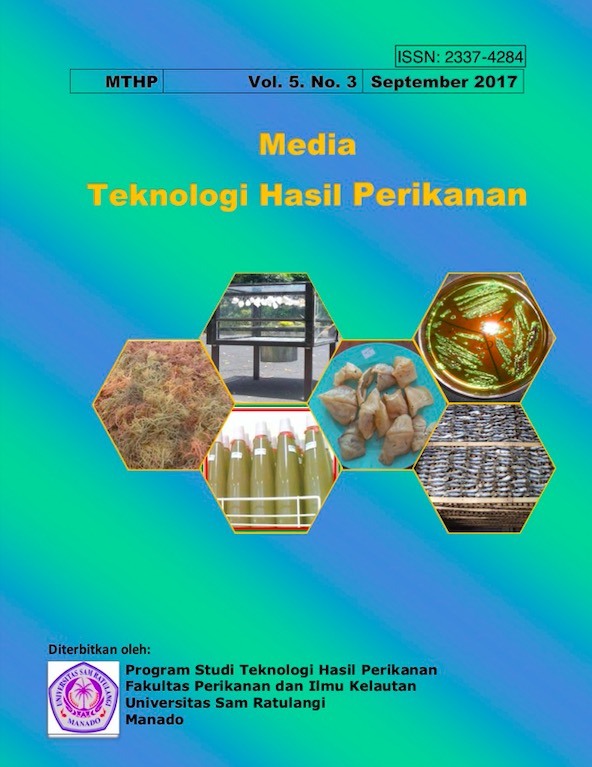KOMPOSISI KIMIA, SENYAWA BIOAKTIF DAN ANKGA LEMPENG TOTAL PADA RUMPUT LAUT Gracillaria edulis
DOI:
https://doi.org/10.35800/mthp.5.3.2017.16865Keywords:
Gracillaria edulis, Bioaktif, Angka Lempeng TotalAbstract
This study was conducted to determine the proximate composition, bioactive compound and total plate count (TPC) in Gracilaria edulis seaweed. This research used descriptive explorative method. The results showed the average value of moisture content (77.7%); protein content (39.4%); fat content (8.1%); carbohydrates by difference (71.7%); ash content (20.7%) and very low bacterial count. Phytochemical test results show this seaweed contains alkaloids, saponins, flavonoids, and triterpenoids compounds.
Â
Penelitian ini dilakukan untuk mengetahui komposisi proksimat, senyawa bioaktif dan angka lempeng total (ALT) pada rumput laut Gracilaria edulis. Penelitian ini menggunakan metode penelitian deskriptif eksploratif. Hasil penelitian menunjukkan nilai rata-rata kadar air (77,7%); protein (39,4%); kadar lemak (8,1%); karbohidrat (71,7%); kadar abu (20,7%) dan jumlah bakteri yang sangat rendah. Hasil uji fitokimia menunjukkan rumput laut ini mengandung  senyawa alkaloid, saponin, flavonoid, dan triterpenoid.
Downloads
Published
How to Cite
Issue
Section
License
Authors who publish with this journal agree to the following terms:
- Authors retain copyright and grant the journal right of first publication with the work simultaneously licensed under a Creative Commons Attribution License that allows others to share the work with an acknowledgement of the work's authorship and initial publication in this journal.
- Authors are able to enter into separate, additional contractual arrangements for the non-exclusive distribution of the journal's published version of the work (e.g., post it to an institutional repository or publish it in a book), with an acknowledgement of its initial publication in this journal.
- Authors are permitted and encouraged to post their work online (e.g., in institutional repositories or on their website) prior to and during the submission process, as it can lead to productive exchanges, as well as earlier and greater citation of published work (See The Effect of Open Access).






